|
We have a new article out in Pacific Journal of Health that explores a case study of tatau. We collected cortisol throughout multiple days for a man getting a Samoan pe'a tattoo. This is the first documentation of the physiological response to traditional tattooing that we know of. Read the full open access text here.
0 Comments
We also have a brand new chapter on the medical anthropology of tattooing in the Oxford Handbook of the Archaeology and Anthropology of Body Modification. This was co-authored with former graduate student Michael Smetana. Mike wrote the first draft for a course, and I slogged away on the rest of it over the course of a year or two. Marco Samadelli wrote a short summary and didn't have time to write a full chapter, so they asked me to combine his chapter with ours. I'm quite pleased with it, though I've already found a few things that will need to be fixed if they retain it for future editions. Check it out here.
Another nice piece recently came about tattooing and immune function that I was interviewed for. This one is in Parade Magazine:
https://parade.com/health/tattoos-immune-system I spent the week of UA's spring break in Samoa to get the project I was awarded NSF funding for in 2020 started finally. I spent 5 weeks this past summer in Honolulu talking with the Samoan diaspora community and had intended to collect similar data in Samoa via coordinated training of research assistants at the Centre for Samoan Studies at the National University of Samoa. However, having only arranged these relationships via email, I could not wrap my brain around how I was going to accomplish those things, and, after chatting with Jessica Hardin, another anthropologist who works with CSS for research in Samoa, I realized the best strategy would be to pay for an extra plane ticket and make the trip to have some meetings in person about the project.
I stayed at the Samoan Outrigger Hotel because it cost about as little as a cheap AirBnB and is located close enough to the Samoan Cultural Village, where Suluape Tatau do hand-tap tattooing, and the National University of Samoa, where I would be giving a talk and have meetings. I went down to the Cultural Village right after I arrived, but no one was tattooing so I popped into a bar overlooking the Village and Apia Bay to see who was around. It was happy hour and full of Kiwi expats talking about their schemes to make money. Felt like a James Michener novel, but I guess everyone needs to make a living. The flight there is super long, and Samoa is 18 hours ahead of US Central Time, so I left on Sunday at 2PM, but I didn't arrive in Samoa until Tuesday afternoon. But I didn't have any appointments until Thursday, so I tried to find everyone on Wednesday. I walked around looking for NUS and CSS for several hours, and I finally found everyone I was looking for after getting thoroughly sunburned and foot-blistered. My stupidity for forgetting a hat, sunscreen, or my already broken in slides. I found Dionne Fonoti in CSS and the main offices and met a few other folks over there. Then I walked down to the Cultural Village and found Ata Sulu'ape tattooing. Junior (Paul) was in Pago Pago, and their father Alaiva'a was at home. Ata told me their father doesn't come down to the Cultural Village anymore, and I didn't have a car so didn't seem him while there. However, right as I was leaving, his daughter Patricia saw on FB that I was in Samoa and sent a message, leading me to realize I could have reached him through the daughters. I didn't think of it though, so next time. On Thursday, I gave a seminar talk about the research I've done and tried to describe the goals and methods I am planning for the Samoa project. The seminar was very well attended with lots of great questions and several people excited to potentially work with me. More on that in a paragraph or so. On Friday, I had some meetings to determine, now that my plans were somewhat clear, how CSS and I could help each other. Much of it revolved around who would be available to take on extra work. I'd be training and paying the person or people, but NUS does have have biological anthropology. They have cultural and language studies and archaeology. There was a medical doctor who is president of the Malofie Association, which is an association of people with the pe'a. I've been trying to catch up with him ever since, but he's super busy as a surgeon and director of the teaching medical program. On Saturday, I had a fruitful breakfast meeting with Dionne, her partner, and Greg Jackmond, the archaeologist at CSS. We talked a lot about the tatau project and generally got to know each other, but I also got the opportunity to hear about some amazing archaeology and bioarchaeology material they have that they're looking for help analyzing. So now, as part of our exchange, I'm trying to find students and colleagues who could help them with this analysis or who may be interested in doing archaeology research there. Contrary to my beliefs that anthropologists have been studying Samoa ad nauseum forever, it's really that anthropologists have popped in now and again and written books but never maintained a constant presence. The archaeology that's been done there has languished since the 1970s, save the occasional study to reify the Lapita story of peopling the Pacific. It's really still unknown why people migrated there or spread out and migrated from there to other Polynesian Islands. However, they have LiDAR data indicating Savai'i was once extensively inhabited, and there is tons of evidence of prehistoric habitation that is completely unexplored. Sunday is the day of the Lord, so no meetings. Frankly, most Samoans are so booked up with chief, village, and church responsibilities on the weekends that they're more busy than during the workweek. So I spent Sunday watching Alabama play basketball (in March Madness, the Saturday night game in Alabama was Sunday morning in Samoa) then went to a hike up to Robert Louis Stevenson's house and grave again. I'd been there last time but got caught in the rain. This time I walked in intense sun and got another sunburn. Monday was the day I was supposed to leave, but since the flight was at 8pm, I had time for some more meetings, which was providential. I had breakfast with Bernadette Samau-Sila, who is a Lecturer in Finance and Marketing. She's Samoa-born but raised and schooled in New Zealand. Shes a qualitative researcher whose methodology is perfect for the study I've proposed, which is why she reached out. She's done some research on the malu and just loves research, and I'm really looking forward to combining our ideas to make this project better. I headed back over to NUS with her after breakfast and went to see Greg's LiDAR maps, which I then played with for several hours until I needed to get to the airport. Our new paper mentioned in the previous post is out, Open Access, in the Nature subsidiary journal Humanities & Social Science Communications. We're pretty stoked to have open access in a Nature journal. Is that big time? It is in my head!
Furthermore, I'm really proud of the students in my lab who stuck in there for Zoom meetings over the course of a year as we figured out how to do a scoping review, write it up, and get it published. Here is the DOI for the paper, where everyone can read it: https://www.nature.com/articles/s41599-023-01511-6 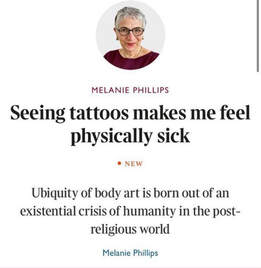 This absurd headline was circulating while we wrote this piece, so we worked it into the article to show how some people apparently think. This absurd headline was circulating while we wrote this piece, so we worked it into the article to show how some people apparently think. My friend Becci Owens, Associate Professor of Psychology at University of Sunderland specializing in evolutionary psychology, had started working on a scoping review of psychological studies of body modification a few years ago but was stalled. I volunteered my lab to help her finish it. It took us about a year to discover that a "scoping review" is a real thing and not another word for a systematic review. After developing a coding system for the corpus of articles Becci had gathered, I googled scoping reviews and found the articles by Nunn like this one that describe scoping reviews in detail and realized that I'd led us all astray for a year. When we refocused on what a scoping review actually is, it became apparent that we simply needed to describe the basic patterns of how psychology studies of tattooing have been conducted. When we started, we noticed that so many of the studies looked for correlations between tattooing and negative personality traits and risk behaviors, despite the fact that most of the same articles and other contemporary sources note that no correlations between tattooing and negative personality traits how been found and that the primary correlations are with openness to experience and youth. So, our secondary objective was to try to understand why so many studies reify tattoo stigma by studying it as though it were a negative behavior and trying to understand causes of such poor behavior. In examining the group of studies that included tattooing as a "stigma" variable in this way (the largest category by far), it became clear that there was a temporal factor. Early studies were looking at penal and mental health populations, seeing lots of tattoos among patients relative to the general population, and trying to determine if marking the self is some aberration of fragile identities. Later studies seemed to indicate that tattooing itself is not a negative behavior but let's just throw it in anyway because we wonder if it might be a useful way to identify people at risk for mental fragility in the general population. But, though I paraphrase, what the hell is that anyway? I have long argued that such studies should just use the Big 5 Personality Inventories because what they're interested in is not risk-taking behavior so much as openness to experience. It appears that by the 2000s, scholars such as Viren Swami had laid to rest with explicit studies saying that all tattooed and non-tattooed people are the same, but even then his titles were ambiguous, leading people to potentially think there are differences if they don't read further (which, shocker, many people don't). Anyway, it became apparent that studies shifted from the above to social psychology studies that look at tattooing in much more interesting ways, such as how tattooing can have different meanings or impacts depending on the type of job you have or how tattooing may intersect with multiple marginalities to influence how people are treated in healthcare settings. These more granular studies are much more interesting. When we looked at the history of the discipline of psychology, the studies we note start after the first renaissance, which was much more recent than generally assumed--tattoos were only out of fashion for about 15-20 years. The pattern of psychology studies also follow the general patterns for research foci in the field of psychology. As of earlier this month, the article entitled "Deviance as an Historical Artifact: A Scoping Review of Psychological Studies of Body Modification" researched and written by Becci, me, Alex Landgraf, Steve Filoromo, and Mike Smetana, has been accepted for publication by Humanities and Social Sciences Communications. Click here to read a preprint of the whole paper. One of our local arts organization, which actually hosts the best folk art festival in the world imho, started a new series for its adult patrons called Kentuck After Dark. I love Kentuck's annual Folk Art Festival, which is coming up in mid-October, as well as its monthly First Thursday events, and so many of the artists and employees there. It's one of the best things about Tuscaloosa. So I was delighted when they invited me to give a tattoo dark for the second installment of Kentuck After Dark on August 18. This was a small ticketed event with wine and cheese. It was easy to chat with everyone, and Molly made some delightful mojitos.
Here are a few photos by my wife Loretta Lynn, including a few of me give a talk about tattooing and immune function from me followed by tattooing with Q&A by local tattoo artist Lucas McDaniel. My kids got their first tattoos from Lucas, so he's had to put up with me ad nauseum, making this an easy event for us to work together. This new article is based on data collected at the 2017 Northwest Tatau Festival and is the first publication of analysis from those data. Summarizing the article in one sentence: "The psychological and physical experience of being tattooed may contribute to physiological adaptations that prepare the skin for other injury." Click on this link to the full PDF. Below is a slide show of photos from the tattoo festival for your enjoyment while reading. 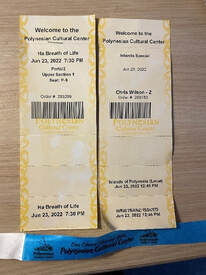 I was impressed with the Polynesian Cultural Center. It seems like a cultural Disneyland, but it's owned by the Mormon Church and staffed by Brigham Young University students. So on the one hand, we expected the cheesiness that apparently appeals to tourist; but on the other hand, we expected religious messaging to mar the presentation. I was impressed with the limited amount of cheese and the complete lack of religious messaging anywhere that I could detect. What I know about Mormonism comes from Rob Ruck's book The Tropic of Football: The Long and Perilous Journey of Samoans in the NFL and Arthur Conan Doyle's A Study in Scarlet. Of course the first is recent non-fiction, while the latter is an old fiction book. But the upshot is that Mormonism doesn't operate the way Christianity does. I've known a lot of Mormons because of their missionary style. My impression is that they go abroad to do service work and set an example but do not actively convert. So a lot of folks like the cultural experience and go into anthropology. A Mormon kid we met had the pule tattoo, which he'd received to settle him down apparently, and he told us that Mormons don't prohibit tattoos. They usually advise against them, but they are OK with cultural tattoos, which is what they consider Samoan tattooing. This is different than what Samoan Mormon kids in American Samoa who accompanied a non-Mormon friend to get tattooed, but I haven't checked this anywhere else. 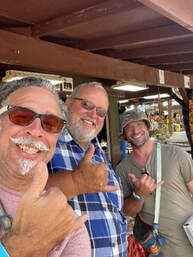 Thanks to Chris (middle) and his wife Patricia (not pictured) for hooking us up! Thanks to Chris (middle) and his wife Patricia (not pictured) for hooking us up! The great thing for us about the PCC is that we were looking for Samoans to interview, and the easiest way to identity Samoans in Hawaii without just asking (which can be weird and potentially insulting for a variety of reasons) is to go to the Samoan Island exhibit at PCC because each cultural island is staffed by students from that island. The catch is that PCC is expensive, and we didn't want to pay to go in and look for people to interview, especially since we were skeptical of this tactic at first. So we went back and forth between the main entrance and BYU campus behind PCC looking for folks and kept getting steered by to PCC. Finally, we went in and stopped by the kiosk owned by friends of Tricia Allen (more on her later), who promptly offered to comp us in for both the park and the evening show (this happened again later in the month when I returned with my wife--we arrived with malasadas the second time, but the effect was the same--having connections is the best!). 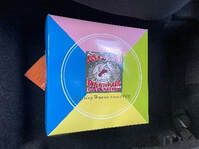 Fresh manapua was delightful but nearly as amazing as Leonard's malasadas (Portuguese donuts) that we picked up the next time. Fresh manapua was delightful but nearly as amazing as Leonard's malasadas (Portuguese donuts) that we picked up the next time. Picked up fresh manapua from Island Manapua Factory in Manoa, just down the road from our room in the East-West Center on University of Hawaii and headed over to TT's parents' house. We were there to pay respects to and watch Su'a Peter Sulu'ape tattoo. Su'a Peter is 8th generation tufuga ta tatau in 'Aiga Su'a, or 8th in a line (according to an interview I conducted with his father in 2019) Samoan master hand-tap tattooist from the Su'a family. The Sulu'ape family have maintained the Su'a tradition for several generations. TT grew up with the Sulu'apes, and she and Peter call each other brother and sister and each others' parents mom and dad. Su'a Alaiva'a Petelo Sulu'ape, Peter's father, explained things to me similarly when I interviewed him in 2019--he has many kids, some of whom are biological children and others he raised or helped raise. Football fans would recognize TT's last name, but I'm sticking with initials here to give her family some relief from the panoptical gaze of football fans. She is the manager of Sulu'ape Skinz, Su'a Peter's handtap tattoo business, and also married to the uncle of at least one professional football player currently in the NFL. In fact, if we'd have popped in on Friday instead of getting "grounded" in our field site by exploring a bit, we'd have met said football star, who was in town to see family and popped in. TT's daughter also goes to Alabama, and I run into her occasionally at the gym where we both work out. She is easy to spot if you know what a Samoan malu looks like. 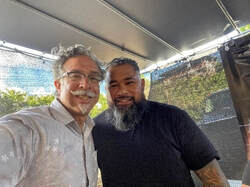 Me (with mouth swollen from trying betel nut with lime) & Su'a Peter Sulu'ape Me (with mouth swollen from trying betel nut with lime) & Su'a Peter Sulu'ape TT's parents have a lovely split level home with an open carport in a nice Honolulu neighborhood near a military base. TT isn't home, but Su'a knows we're coming and greets us upon entering the carport. A fale is set up in the carport, and the carport has been extended with awnings to create space for viewers to set off to the side. Immediately upon entering are tables with chairs around it and several bags of McDonald's someone brought (everyone brings food, so there is food arriving all day). We meet Su'a's toso and wife. Su'a is the title and name of someone who apprenticed in the Su'a guild and who was gifted the title with tatau tools by a tufuga ta tatau. Toso is the Samoan word for the stretchers, who stretch the skin so Su'a can tap. The toso include ED, a Samoan language instructor who I had been trying to contact separately, as I had learned that he has the pe'a (traditional Samoan tattoo for males) and knows all the Samoan tattoo artists. Knows? He has been toso for Su'a Peter since 2009 and travels all over the world with him. Little understatement. The other main toso is Su'a Peter's brother-in-law, who received his pe'a in November 2021 and began working with Peter as toso. We all chatted for about 30 minutes. We inquire about learning the Samoan language and are told of ideas for an online Samoan language course that might interest us but also of an app we can use to learn words and how they are pronounced. He also suggests we listen to the audio version of the Bible in Samoan, because it has more Samoan words in it than any other translated document, and it's easy to put it next to an English translation to make sense of the grammar and syntax. As we're meeting everyone, they tell us they'd just been to Alabama. I knew Su'a and TT had been there but not this whole room of people. The whole crew, Su'a and his wife, TT and her husband and parents, both main tosos, and TT's nephew had all been to Texas in March and had come to Bama to visit TT's daughter. We were supposed to get together in Bama, but our schedules didn't line up. The funny part is that got a tour of the athletic facility, including Coach Nick Saban's office. They got to sit in Saban's chair and try on his championship rings! Let me put this into context: Su'a and his wife and BIL all live in New Zealand. BIL is a rugby fan and doesn't even watch football (there is a time zone issue even the poor people of Hawaii have to deal with--noon kickoffs on the east coast is 6 am for them--that's a dedicated fan who gets up at 6am on Saturday), but he got to sit in Nick Saban's desk chair and try on the championship rings. I am a full professor at the University of Alabama, and I have not even seen inside Nick Saban's office. (Though if I'm being honest, I haven't tried and haven't toured the Bryant Museum or toured the athletic facility since I was hired in 2009, before any of Saban's championships or Heisman trophy winners, etc.). But I digress. Then Su'a and the toso went to work. There is a mat spread out on the ground for the tattooing area. Two big lights are set up behind the tufuga and fans are set up on either side to keep the bugs off and sweat down. There are customs to be followed to enter the fale: Everyone must wear ie (lavalava), shoes off, no hats or sunglasses, no video/photography/social media during sessions, and soles of one's feet should not be pointed toward elders. The toso stuff pillows into plastic bags, push all the air out, and tie them off for sanitary padding. Bandanas receive the same treatment and are used to support the 'au (the hafted tattoo instrument). Su'a Peter prepares the various 'au (which he keeps in multiple sizes in a traveling case) by tying the needles to the head of the tool. The titanium needles are soldered together and replace the traditional boar tusk that was previously carved. Boar tusk do not maintain as much sharpness, so I am told that tattooing with the titanium combs is faster, cleaner, and heals better than bone combs. To tie the needles on, he pulls out a long piece of synthetic string (like dental floss), holds the end on top of the needles with one finger, wraps the string around 20-35 times, places a small loop of string on top, passes the end of the other string through the loop, wraps it a few more times, and pulls the loop out, which tucks the end of the string into itself without the need for a knot. 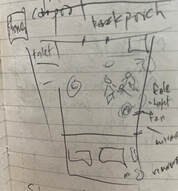 No photography, video, or live streaming during tattoo sessions, so I drew a sketch to remember the layout. No photography, video, or live streaming during tattoo sessions, so I drew a sketch to remember the layout. Now is time to start tattooing. The tufuga and toso sit cross-legged on the mat with their first client between them. The first client is a Samoan guy who came by himself from across the United States. The "by himself" part is a bit of an issue, since they're told to bring someone who can help wash them and massage the tattoo to prevent scabbing and infection. Mike (UA doctoral student Michael Smetana was my research assistant on this trip) and I move to the floor so we can watch more closely. The chairs need to be moved to the opposite side of the table away from the fale. Su'a begins marking the arc that will go on each hip. Yesterday, he started with the pe'a (bat) on the back. Today one flank, tomorrow the next, and so on over 5-10 days, depending on the number of clients. Today, he's working on parts of four pe'a and doing one whole malu. Su'a works on him for around two hours. We listen to the Sulu'ape Skinz playlist they have prepared for work, and the sound of the sousou tapping on the 'au gives a second backbeat to the music. (I always come home with a few new tunes or artists to add to my own playlists--this time it's The Five Stars and Mr. Tee).  Plumeria tree, which grows all over Oahu, is a main source of flowers for lei. This is part of TT's father's garden. Plumeria tree, which grows all over Oahu, is a main source of flowers for lei. This is part of TT's father's garden. TT comes home around 11:30 AM and beckons us to the back porch area. We slip our shoes on, walk around to the back, and she shows us the yard and such (including a baby 'ava tree!). They have a giant mango tree growing in the back, and occasionally one falls, making a loud boom on the plastic roof, before it drops into the yard behind the fence and rolls down the hill! Fortunately, they must rescue enough that TT sent us home with four juicy mango. We sat in the back area chatting because it's difficult for most people not raised to it to sit cross-legged on the floor for long and because it's rude to carry on with conversation next to them tattooing. TT caught us up on their travels schedules, COVID19 issues, etc. We learned, for instance, that tattoo shops were closed for 1.5 years, so many never reopened or had to go underground to make a living. Soul Signature, the shop of Samoan-Tongan tufuga Su'a Sulu'ape Toetu'u Aisea, closed its street-level shop and moved to a high-rise, where they do work by appointment only. I had originally met Su'a Peter at the same time I met Su'a Aisea, when I stopped into Soul Signature on a Hawaii stopover just to get a sense of Polynesian tattooing in Hawaii. We were going to pop in again until we saw on their website that they weren't doing walk-in business anymore, but I had no idea they'd moved. ED comes back to talk with us and stretch out his back. The strain the tufuga and toso put their bodies through to sit on the floor for 8-16 hours is epic, and they pay the price. Other things I learned that I can share here: Su'a Paul Jr. Sulu'ape (Peter's brother) has gotten remarried, and they have a one-week-old baby boy. So I sent him a belated happy father's day via Insta, since I'm not able to get to Samoa this year. 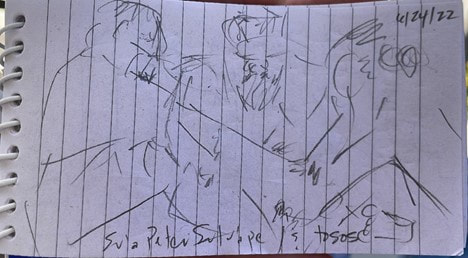 Sketch of Su'a Peter Sulu'ape & two toso (stretchers) Sketch of Su'a Peter Sulu'ape & two toso (stretchers) In addition to all the food people bring, TT makes sure they have whatever Su'a and the toso need, so there are flats of soda, water, Gatorade, Monster, Alohas, and canned cappuccino. I down a Monster while we chat, then we go back to the mat to watch the next pe'a. We watch this one all the way through, picking up the hand fans to help out keeping the bugs off. Afterward, the man's wife asks us what we're doing and chats with us about the importance of religion in Samoan tattoo. I'm fascinated and will be processing that one in my brain for a while. That in addition to a comment made that Samoans in Hawaii who belong to a Samoan church maintain the Samoan culture, and those that aren't members of a Samoan church do not, because it is the churches were the center of village life in Samoa. Everyone sits around the tables to eat some food while they take a break. I have a manapua and a can of cappuccino. Much better than the manapua I ate for dinner out of the nearby 7-11 on my first night, since nothing else was open by the time I was dealt with by the rental car company (just a little double-bind in which first my travel agent booked my rental car for the layover airport instead of the final destination, and then I forgot to renew my drivers' license before leaving). Then the other brother gets the same part of his pe'a done, which we sit and watch until around 4 or 5. Then it's time for dinner. Su'a invites Mike and I to come sit with him, and they divvy up the dinners that the two families have brought for everyone (part of their responsibility). Food is also prepared upstairs and brought in. There is a steam cooker of white rice and a meat and veggie soup. The meals are teriyaki chicken and beef, garlic shrimp, and white rice with macaroni salad on the side (to keep it cold). There are several containers of poke in coconut milk as well. After each client finishes their session, they go into the shower that is set up via a hose in a tent in the back to wash and have the tattoo massaged. After this, they help clean up the food then leave. Another family will have arrived in the meantime and are preparing for the next session. Between each client, the toso roll up the mat from the previous client, tear the bags off the pillows and replace them with new ones, strip the needles off the 'au and autoclave them. Su'a puts newly sanitized needles on with fresh string before each client. 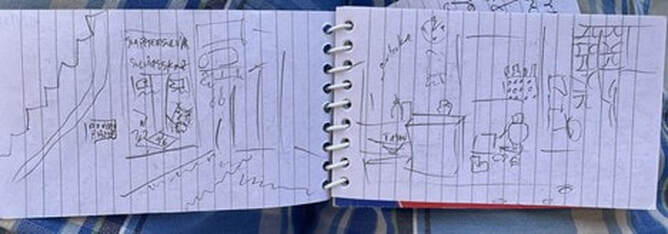 Two more sketches of the fale in the carport Two more sketches of the fale in the carport After dinner, Su'a administered a malu. Aside from making the initial arrangements and making sure the client arrives with everything they are supposed to bring, TT stays out of the art and technical aspects. So she was speculating with us as we took a break after the first leg of the malu was completed to chat. The client's father was from American Samoa, as attested by his ie, which was a tailored ie faitago with pockets and belt loops, as opposed to ie lavalava, which is called sarong in other places. This ie also suggested he might be a church leader, as the style and pattern are associated with them. Furthermore, as Tracy indicated, the double malu (the malu is the whole traditional tattoo worn by women in Samoa, but it is also the name of the main symbol of the tattoo, a diamond on the back of the thigh) is reserved for daughters of priests and similarly high-ranking people. And the mother of the girl was also wearing a dress associated with church leaders' wives. She said she thought the girl's father might be a bishop. Initially, my eyes had been drawn more to his Michigan Wolverines shirt, so I'd been planning to talk football if we started chatting. I met both of TT's parents while we were there, and they were very gracious and lovely. Her mother especially came down to watch and chat and was very generously teaching us Samoan words. She told us about her son the inventor too. He invented a toilet seat that sanitizes itself called "Washie." It's pretty ingenious, I gotta say. We've all struggled with those paper rings that we place on public toilet seats--the middle part falls in the water, gets wet and heavy, and pulls the whole ring into the water before we can land our hinies on them. Furthermore, public toilets during COVID19? Fuggetaboudit. So he invented a toilet that squirts sanitizer on the seat that you just wipe off with a little piece of toilet paper. Genius! TT was going to be the distributor (she has a few jobs), but they have licensing interest from a big public toilet company. The money is in the liquid to refill the toilet seat, so maybe Washie will be the next Harry's or something. Why not a subscription for Washie refills? When the malu started back up, we scooted back down onto the mat to watch, though by this point our hips were screaming so badly it was difficult to sit there. Don't get me wrong--tattoos are painful, very painful sometimes, and I found the handtap style even more painful than electric, though I admit it's been many years since I got an electric tattoo--but the real pain being experienced in that room is by the toso and, to a lesser extent, the tufuga. The Old Man, as all his family respectfully refer to Su'a Alaiva'a Petelo Sulu'ape, grew up sitting cross-legged everywhere and seems to suffer not at all. Su'a Paul Jr. told me how painful it is for him, that the numbness causes him problems. TT worries for Su'a Peter's health, not just because of the posture he maintains, but the long days he works. Those of us unaccustomed simply cannot hold the posture for long after the first hour or so. I switch my legs back and forth to ease pain. The mat chafes the sides of my feet, so I wrap my arms around my knees and hold them up. Later, all I can manage is to fold them under me to either side and switch back and forth. By the end of the 16 hours stretch, I had to do it very slowly because spears of pain would shoot up through my back, and I was trying to keep my poker face. Other toso popped in for shorter stints, and TT's husband came in during the 2nd or 3th pe'a as a 3rd stretcher. I can see it causes them all problems to sit that way, and it is something we all note and comment upon over the course of the days' sessions. Because this client got the double malu (malu is technically a specific pattern within the larger tatau, as the pe'a is the bat image of the male tatau, but the whole piece is also called pe'a), it took a little longer than usual, and Su'a finished her up around midnight. Even though they'd told us that he was doing parts of four pe'a, I couldn't imagine him starting another piece that late or of the person showing up ready to be tatted at that hour. But he did, and he did. Apparently, he has TT book up to five pe'a at a time sequentially in different cities, so he works under deadline and maintains his timeline hell or high water. Apparently he'd been at it till 6 the night before and 3 another night and had even worked on Sunday, which is unusual. We stayed until 3 when they wrapped up, but we did not go back the next day at 9 when they started up again. #Beastmode By the time of the last pe'a, Mike and I were both brain fried. I was groggy from dinner for a while, then started to get a headache, as the pain from my ass radiated up through my body. Around midnight I drank a Coke, ate two donuts (at our donut break), and drank a full cup of cold McDonald's coffee of the six that had been brought over earlier in the day. Helped my headache. By the time of the end of the malu and the last pe'a, my hips hurt so bad that I'd moved up to a chair behind the table. However, Su'a Peter kept an eye on everyone throughout the proceedings. When he wanted anything, he'd whisper to a toso who would turn and ask anyone but Mike or me. I think that was out of respect, but at one point I awkwardly asked him at his own house if there was anything I could get for him, just so I could feel useful. One of the things I love about working with Samoan tufuga is that he chats with the toso the whole time they work, and they laugh a lot, and I like joking around with them too. They have great senses of humor, so it's easy to cut up with Su'a. However, one of the things I don't love is that I don't know their language and so want to know what they're laughing at and never do. So there is always a bit of awkwardness in trying to relax into a situation wherein everyone is laughing but you and you have no clue what the joke is. Anyway, Su'a is keeping an eye on things, so I don't want him to catch me drifting off in the chair and bust my chops over it, so I slip back onto the floor for one last stint, figuring the pain would keep me away. Somewhere along the way I read that Samoans consider it rude to sit and write things down in front of people. So they will listen politely and, if they need to write something down, they do it after the fact. So we don't take as many notes during these sessions as we would if we didn't care about appearing rude. I say this by way of noting that there are several things I learned or that people said, but since I wasn't taking my scratch notes on pad in my pocket throughout the course of the night, I don't have an accurate recall of the order of all events. Not that it matters. Other interesting things I learned: Su'a Peter is collaborating with the same liaison I work with at the Centre for Samoan Studies at the National University of Samoa on Moana II! Su'a was the consultant for the tattoos of Maui in Moana, and they consulted him again on the script for the sequel, but they had Moana getting half a malu, then running away and leaving it unfinished until the third movie. That's something that wouldn't happen, and no one knows of it happening. The closest TT could relate was a girl who found the malu so painful that Su'a had to stop and send her home to recover herself so it could be finished the next day. Unfinished pe'a and malu are considered shameful to everyone--the tufuga, the family that paid for the tatau and put the person forward as ready, and of course the person. Unfinished pe'a are called pe'amutu, and one way to spot them is if someone has the pe'a peeking out of shorts at the knees but never takes their shirt off because they don't want people to see that they didn't get the pute (navel), which is the last part done and is in, well, the bellybutton. But that's pe'a, which takes like 30-35 hours, as opposed to the malu, which is 3-6. No island girl would run away with an unfinished malu for more than one evening if that, so Su'a Peter refused to be involved unless they fixed it from a cultural perspective. Cool, right? Su'a kept his ink in an Alabama coffee cup. I forgot to get a photo, but Roll Tide. So yeah, Su'a finished up at 3 am. We said goodbye to everyone, wobbled out, spent a few minutes discussing, then got to sleep so we could make our appointment the next morning to drive up to the pa of Kawika Au, a Hawaiian hand-tap artist I first encountered when he was stretching for at the 2018 Northwest Tatau Festival. But more on that next post... |
Christopher D. LynnI am a Professor of Anthropology at the University of Alabama with expertise in biocultural medical anthropology. Archives
May 2023
Categories
All
|



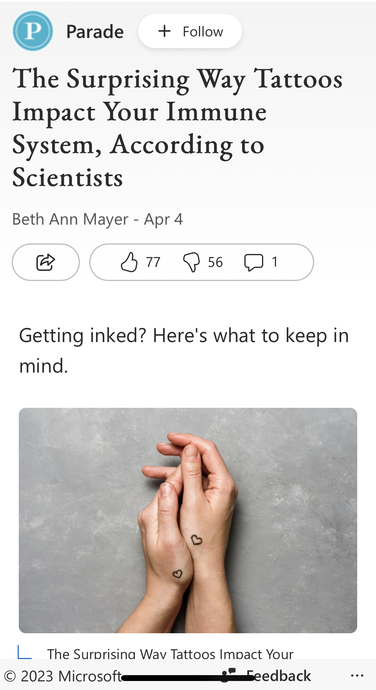
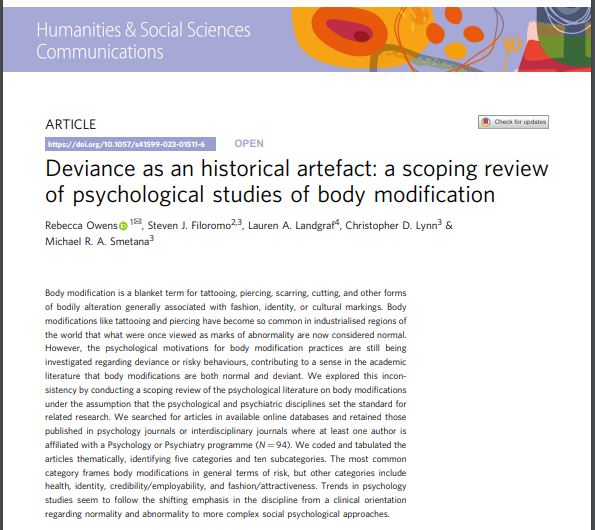
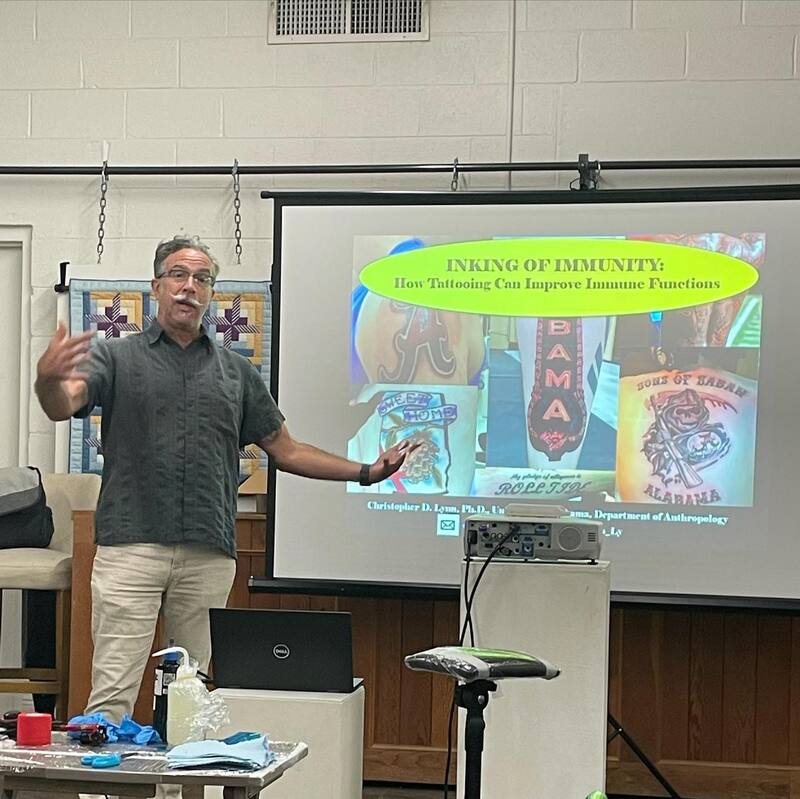
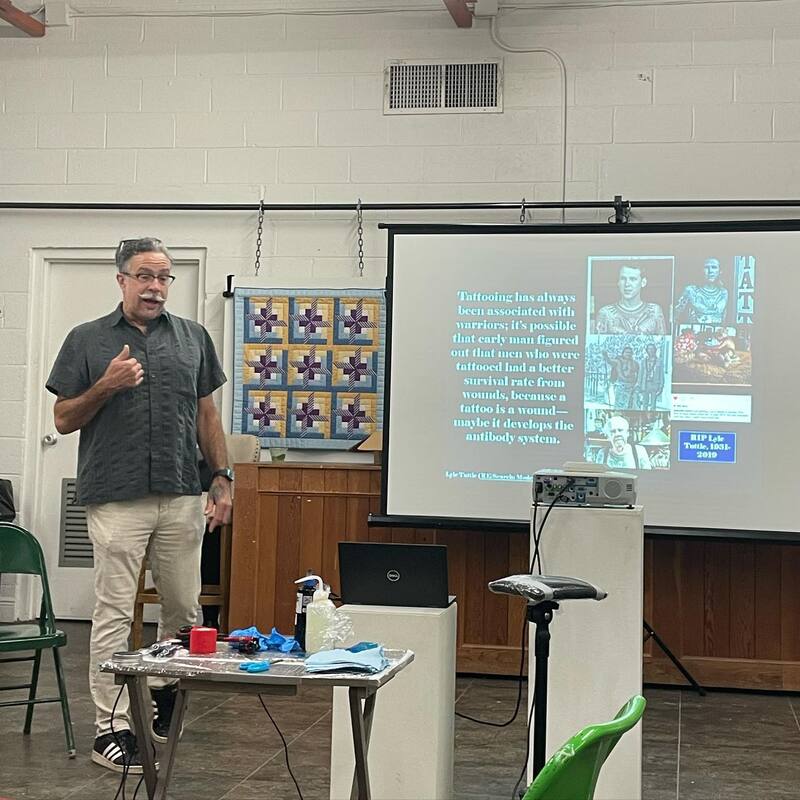

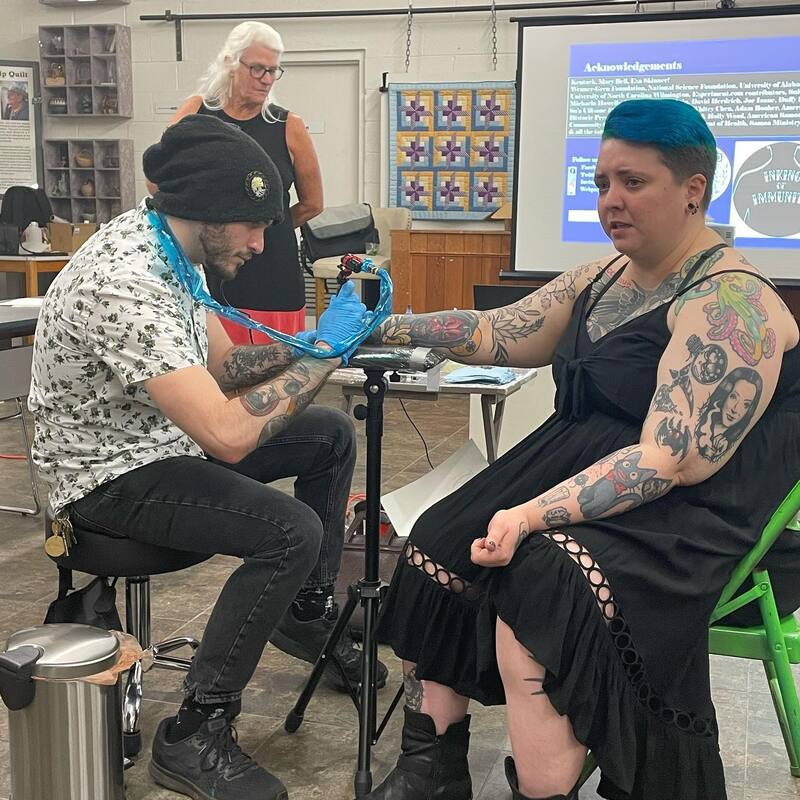
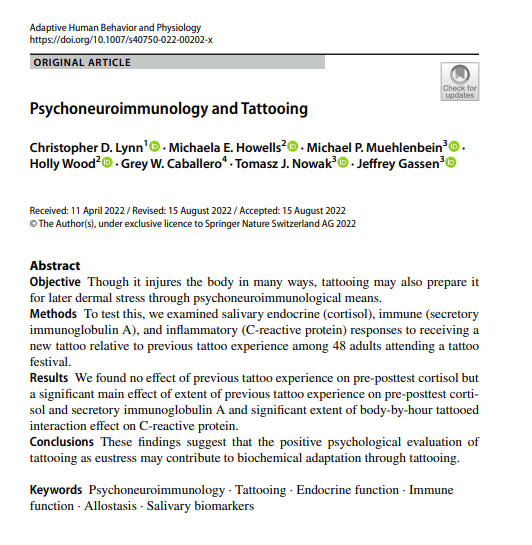

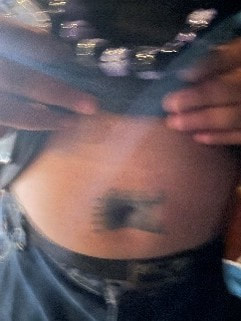
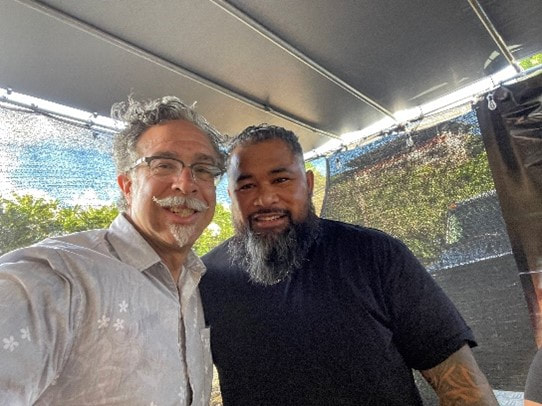
 RSS Feed
RSS Feed
